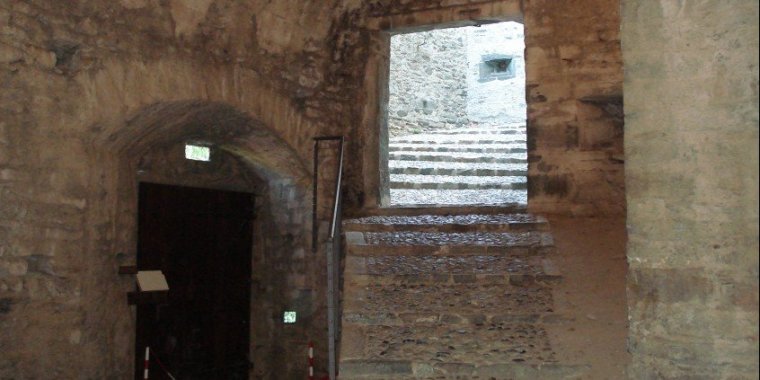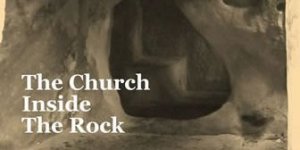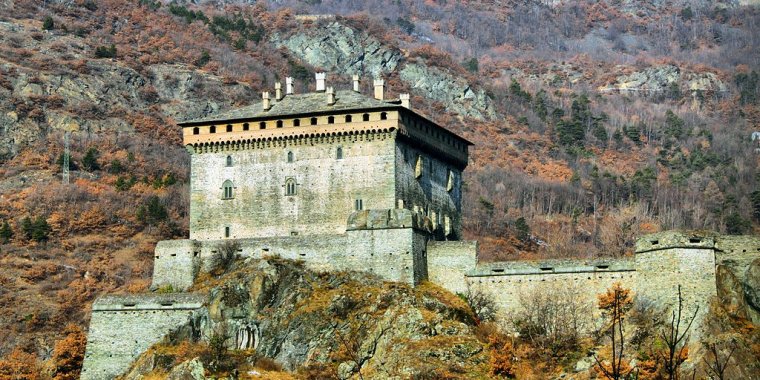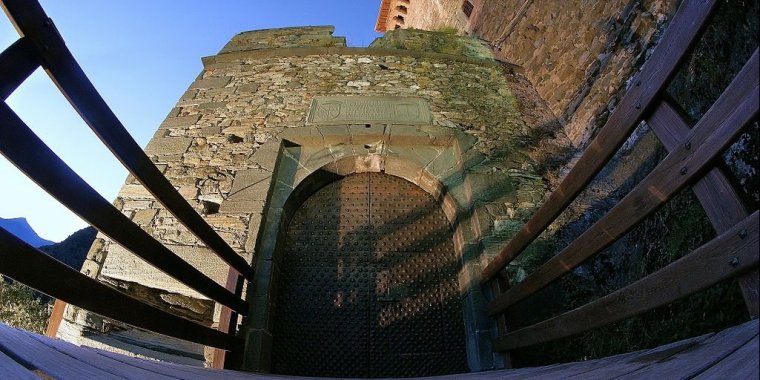| Published in Attractions / Places of Interest |
Verrès Castle (Castello di Verrès, Château de Verrès), Italy
Verrès Castle (Castello di Verrès, Château de Verrès) is a fortified 14th-century castle in Verrès, in the lower Aosta Valley, in north-western Italy. It has been called one of the most impressive buildings from the Middle Ages in the area.
Built as a military fortress by Yblet de Challant in the fourteenth century, it was one of the first examples of a castle constructed as a single structure rather than as a series of buildings enclosed in a circuit wall.
The castle stands on a rocky promonitory on the opposite side of the Dora Baltea from Issogne Castle. The castle dominates the town of Verrès and the access to the Val d'Ayas. From the outside it looks like an austere cube, thirty metres long on each side and practically free of decorative elements.
The earliest documents attesting the existence of a castle at Verrès (in the possession of the De Verretio family) date to 1287.
Around the middle of the fourteenth century, the De Verretio became extinct without leaving any possible heirs, so their property came into the possession of the counts of Savoy, who granted it to Yblet de Challant in 1372 as a reward for diverse duties discharged in their service.
Yblet entirely rebuilt the castle, producing a fortress that was practically impenetrable and distinct from most of the contemporary castles of the region which consisted of a number of buildings surrounded by a circuit wall.
In 1536, René de Challant renovated the fortress to take account of the appearance of firearms, with the help of the Spanish captain Pietro de Valle, a famous military architect. He had the base of the cubic structure surrounded by a circuit wall with counterforts and polygonal turrets, adapted to cope with cannons and equipped with pieces of artillery brought from his fief of Valangin in Switzerland.
René must also be responsible for the current vestibule, accessed by a drawbridge, for new windows and for new gates with Moorish arches.
After a series of transfers it was finally acquired from Alfredo d'Andrade in 1894 by the Italian state in 1894 and placed under the Superintendency for monuments of Piedmont and Liguria, which carried out restoration work.
After the Second World War, the castle was declared a Monument of Italy and came under the authority of the Regione Valle d'Aosta which rebuilt the stone casing in the 1980s. A final restoration was undertaken in 1994.
In 2004 the castle was closed to allow strengthening and adjustment of the structure. Since it was reopened in 2007 it has been open to guided tours.
The castle, constructed as a military fortress, sits atop a rocky premonitory above the river Évançon and dominates the town of Verrès. In addition to being difficult to reach and easy to defend, its position allowed it to control the country below: the central valley and the Val d'Ayas pass which was then an important route.
Externally it is an austere cube, about 30 metres on each side, surrounded at the base by a circuit wall which encircles the entire summit of the peak. The walls (some more than 2.5 metres thick) are surmounted by a continuous line of battlements, which hide a storm drain, with Medieval mullioned and Renaissance cruciformed windows.
Every element of the castle seems to have been considered to make the fortress more defensible. The visitor ascends on foot along a mule track, which winds up the mountain until it reaches the entrance in the circuit wall, accessed by means of a drawbridge. This entrance, like the external circuit wall, was built by Rene de Challant in the sixteenth century, as indicated by the inscription above the gate.
As the visitor follows the path up to the castle, the fortress is always on his right side. This was another defensive feature, since the soldiers of the time usually carried their shield in their left hand and therefore the right side was exposed.
Beyond the gate there is a vestibule with a curving stairway to make it difficult to use a battering ram. In this space there is a door which leads to an inner compound, once occupied by the stables, and to the ramparts -not accessible to visitors.
Above the vestibule is the gatehouse, on top of the dungeon and now the location of the ticket office for visitors to the manor. Its front is the true entrance to the castle - a round arch and a pointed arch with a wooden door reinforced by nails in imitation of the original door.

Entrance to the castle of Verres. ![]()
Inside the castle is a square entrance hall roofed by a vault of pointed arches, a further defensive element. Several loopholes look into the hall and there is a trapdoor in the ceiling from which it would have been possible to bombard any invaders trapped inside.
In order to actually enter the core of the manor it is necessary to pass through a double door with a round arch on the side facing into the entrance hall and a pointed arch on the side facing the inner courtyard - once protected by a portcullis separating the two doors.
The inner courtyard of the castle is a simple square area from which two large halls, positioned on the east and west sides of the manor, can be accessed. The courtyard is open to the sky, allowing greater illumination of the rooms and the collection of rainwater in the grand cistern located below it.
The pavement of the courtyard is sloped so that all the water converges at the centre, where there is an opening into the cistern. This reserve supply of water would be precious in the event of a siege.
The internal division of the castle is as simple as its exterior appearance. The ground floor is composed of three rooms in addition to the entrance hall, which surround the inner courtyard.
The entire eastern side of the castle is occupied by a large rectangular room covered by a round barrel vault. This was the only unheated room of the castle and most likely served as a warehouse and armoury. It is used as a ballroom during the annual celebration of the historic carnival.
On the opposite side is the large west hall, accessed by means of a gateway and covered by a pointed barrel vault. This hall, probably used for housing and dining by the soldiers and service personal, was heated by two massive fireplaces and connected to the kitchen on the south side of the ground floor by a serving hatch and to the kitchen on the northwest of the floor above by a staircase.
A loophole looks into the entrance hall from this room. At some points here, the rocky ground pokes through: the castle is actually built into the naked rock and it would have been impossible to the remove the aforementioned rocks without compromising the structure's stability.
The first floor was reserved for the lord of the manor. It is reached by climbing up the monumental stairway on flying buttresses extending about two metres from the courtyard walls, which climb up the internal walls of the building.
The architrave of the first door which a person first meets as they climb the staircase bears the inscription which records that Yblet de Challant built the castle in 1390. The door itself leads to a room used as a gatehouse, which is located above the entrance hall. In the floor there is the trapdoor which allows bombardment of enemies in the room below. The room is lit by a window on the north side, through which it is possible to see Villa Castle in Challand-Saint-Victor.
A second kitchen for the garrison is accessed from this room, once connected to the hall on the ground floor by a staircase. The room is provided with a hatch which opens into the void on the northern side of the castle, like the rooms above and below - perhaps a form of secret escape route.
The room also has a pantry in the wall, with a hole to allow the cold from outside to better conserve the food, and a fireplace in the wall which is shared with the lord's dining room, which had the double function of cooking the food and warming the adjacent room.
From the kitchen there is access to the room which served as the lord's dining room (also accessible from the staircase in the courtyard). This room occupied the rest of the waestern part of the floor. The hall was heated by two large brasiers located in the corners and was connected to the kitchen on the north side of the castle by a hatch.
The room was lit from the outside by mullioned gothic windows and from the courtyard by a fourteenth century quadrifora window.
The lord's kitchen, located on the south side of the floor has three large fireplaces. The one on the side opposite the courtyard is of exceptional size and was originally designed to cook whole animals inside it. The room is covered by several ribbed vaults from the time of Rene de Challant, which have his coat of arms and the letters R and M (the initials of Rene and his wife Mencia) at the centre.
This is the only part of the castle's roofing which is original - the rest was restored in the twentieth century. The eastern side of the kitchen is taken up by some cupboards on the wall and by a large pantry built into the wall.
The east side of this floor is taken up by the lord's bedrooms, heated by large stone fireplaces, covered by a cofferred wooden ceiling and equipped with a total of five latrines in the wall, which emptied onto the rocks below.
The second floor of the bastion, which cannot be visited on the guided tour, replicates the division of the first floor and was probably used by functionaries and guests of the castle. Above the lord's dining hall is a hall, probably used at some point as a council hall. The wooden roof and stone fireplace of this hall, like those in the other rooms on this floor, were reconstructed and restored in the last few decades.
They had been ruined by the weathering, to which they were exposed after the removal of the manor's roof. The rooms on the east side have two latrines like those on the first floor. The room above the kitchen in the northwest corner contains a hatch leading to a ledge on the outside, possibly used as a service exit or perhaps for signalling.
Wooden stairs, completely reconstructed, connect this floor to the attic. The rooms of the attic are subdivided in the same way as the floors below and were probably used by the soldiers and servants of the castle and for storing rocks. Going out from the attic, it is possible to access the Chemin de ronde which runs around the outside of the four sides of the building for about 120 metres and contains 148 machicolations.
Going inwards there is a wooden gallery which faces the interior courtyard and whose roofing serves to drain rainwater into the courtyard. The stone roof was completely reconstructed in the 1980s.
Tourist Info
Opening:
Access: entry allowed for groups up to 25 people per visit. Last tour 30 minutes before closing time.
• April to September: 9 a.m. – 7 p.m. daily
• October to March: open Tuesdays to Sundays 10 a.m. – 1 p.m. / 2 – 5 p.m.
Closed from 9th to 13th January and from 17th February to 2nd March 2020
Admission:
• Full price ticket: 3.00 euro
• Reduced entrance-fee: 2.00 euro (groups of at least 25 paying visitors, university students, specific deals)
• Under 18s reduced entrance-fee: 1.00 euro (visitors aged 6 – 18, school groups)
• Free:
— children under 6
— visitors with disabilities and their companions
— teachers and other persons accompanying school groups, 1 person per 10 students.
Passes for the visit of several sites are on sell directly at the castle’s ticket office.
Rules for visitors
People with disabilities: not accessible.
Photos and videos: it is possible to take pictures and videos, for private use and not for gain, with any device without flash and support. Shooting with selfie stick is forbidden. Using shots and films for advertising, press or commercial purposes is allowed only upon authorization.
Pets: small animals are admitted inside the monument only if held in one’s arms or transported in a pet carrier.
Sources
• www.wikipedia.org
• www.lovevda.it
YOU MAY ALSO LIKE






 If you own or manage a travel-related business such as a hotel, a bed-and-breakfast, a restaurant, a pub or a cafeteria, you can create a web page for your business for free on Titi Tudorancea Travel Info. » |

